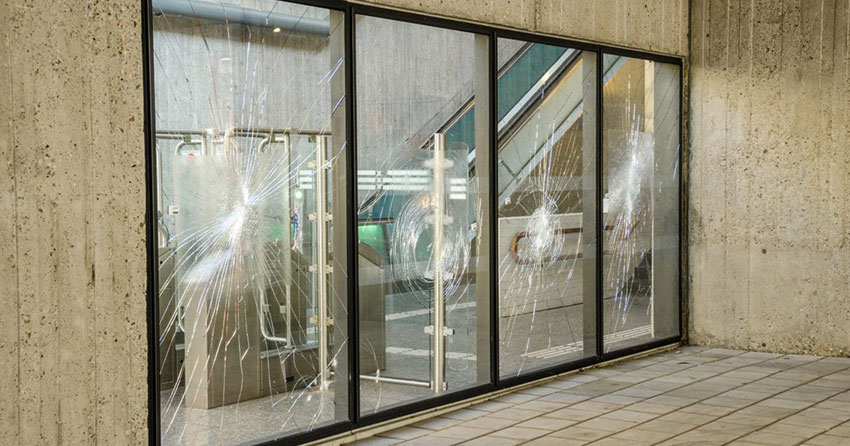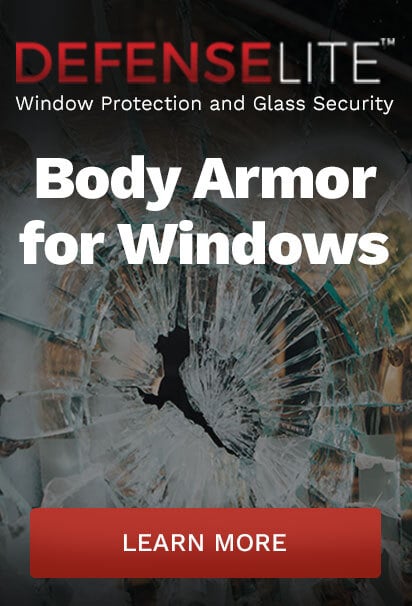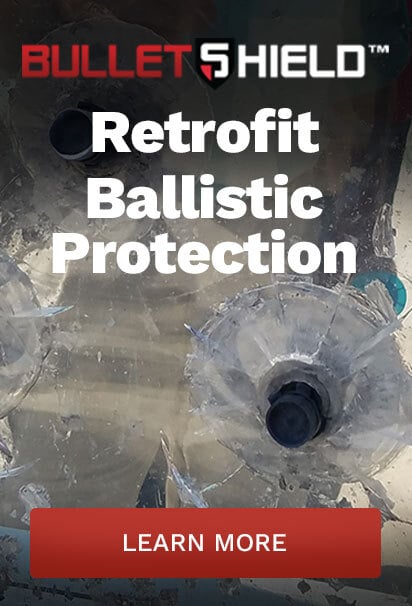Shatterproof Glass: Do Unbreakable Windows Really Exist?

There are a number of options available that sell themselves as “shatterproof glass.” But the issue with that term, shatterproof, is that many products that claim to be shatterproof are actually only shatter-resistant and can still be broken.
In simple terms, virtually all forms of glass can break. It’s just a matter of how it breaks, such as the break pattern and if the glass will remain in the opening—or vacate the opening leaving the interior of the building vulnerable. These subtle differences in glass types can help you choose an option that best suits your safety and security needs.
Whether you’re looking for a solution to protect windows and doors from smash and grab attempts or more severe threats like bomb blasts and natural disasters, it’s best to have a thorough understanding of what your options are and which provide the best protection for your needs.
Why Protect Your Glass?
When left untreated, the traditional glass in windows and doors will shatter into shards, called spall, upon impact. These shards can then be propelled at high velocities, which becomes a dangerous hazard to building occupants. In fact, spall is one of the top causes of serious injuries that occur from natural disasters like hurricanes and attacks from bomb blasts.
In addition to protecting building occupants from flying debris, reinforced glass can also prevent entry from bad actors like thieves and, in some cases, even prevent ballistic attacks. The capabilities of the glass all depend on the type of reinforcement you choose.
There are generally three options to choose from:
Window Films
These “shatterproof” glass films, applied on top of existing glass, are made up of multiple, micro-thin polyester layers designed to hold broken glass fragmenting together and improve overall glass protection.
Laminated Glass
Often labeled as shatterproof glass but most certainly still breakable, laminated products are produced using glass combined with a polyvinyl butyral (PVB) or resin interlayer providing a reinforced glass much like the glass used in car windshields that will remain intact upon impact.
Polycarbonate Panels
These polycarbonate panels can be installed over existing glazing to provide an extra layer of protection 250 times stronger than glass, making it even more difficult to penetrate than the other options many cases, bulletproof as well.
Shatterproof Window Films
This option isn’t actually a type of glass, but a film applied on the surface of the glass to add an extra layer of protection. These films are transparent, resilient, and can also provide additional benefits of energy savings and UV protection to keep merchandise looking its best.
While they aren’t “shatterproof,” the film’s polyester layers will hold the glass together upon impact, protecting those inside from dangerous flying debris and slowing down invasion attempts. Window films vary in thickness, with thicker films providing more shatter resistance.
However, the shatterproof window films will not fully protect against ballistic attacks and do not provide as much defense against motivated criminals as some of the other options. Security window films are ideal in situations where the existing glass can’t be replaced. They are often less expensive than laminated glass or polycarbonate panels, so they should not be expected to perform at the same capacity.
Laminated Glass
Much like security window films, laminated glass is often referred to as “shatterproof” and even “bulletproof” while it actually falls into the category of “shatter resistant.” It’s manufactured by bonding layers of glass and interlayers together. The interlayer then acts in the same way a security film would, by holding the glass together even when damaged to prevent dangerous glass shards.
Because the glass has been reinforced, it can delay forced entry attempts by several minutes, often enough time to deter a criminal from continuing their attack. Depending on the thickness and interlayer type, laminated glass is usually adequate for situations of smash-and-grab, burglary, and looting for retail storefronts and other businesses but can still be breached by a motivated criminal in some cases.
Laminated glass also replaces existing glazing solutions, rather than being installed over existing window and door glass. This can be an expensive, labor-intensive investment over other alternatives like films and polycarbonate panels which can be retrofit onto the existing framing system.
Polycarbonate Panels
If you’re in need of the best defense against any kind of threat, polycarbonate panels provide superior protection against smash-and-grab forced entry attempts, active shooter situations, natural disasters, and bomb blasts. Polycarbonate is much stronger than any of the other options listed above while still providing a similar appearance to glass, allowing light to enter and maintaining external appearances.
Made of a combination of polycarbonate, acrylics, and other plastic resins, this retrofit solution installs over existing window and door glass, creating a gap that keeps the glass intact even in the most serious of attacks. They combine the best of materials science to create a solution that is truly unbreakable and impenetrable. Even laminated glass or glass enhanced with a security film is much easier to breach than polycarbonate security glazing like DefenseLite.
Some of these products have even been enhanced with bullet resistance, like Bulletshield. These ballistic glass products should be used in areas in need of the most protection, like schools, government buildings, and hospitals. BulletShield has been tested with a wide range of firearms and rated to UL 752 standards, ensuring that the bad guys stay out.
It’s important to note that not all polycarbonate panels are created equal. In some cases, polycarbonates and acrylics get a bad rap because they can discolor over time. Additionally, some products are subject to scratches and haze. DefenseLite products have been designed with these issues in mind. They provide optimal UV and scratch resistance, so they won’t discolor, or scratch over years of use.
DefenseLite and BulletShield
When enhancing the security of any building, glass windows and doors should be at the forefront of everyone’s minds. Standard glass is an area of weakness, providing a point of entry for criminals and the potential for injury from spall. DefenseLite and BulletShield can both be installed to provide top-of-the-line defense against criminal activity or natural disaster. If it’s important that your glass truly lives up to being shatterproof, then consider products like DefenseLite and BulletShield for optimal protection and visual quality.


